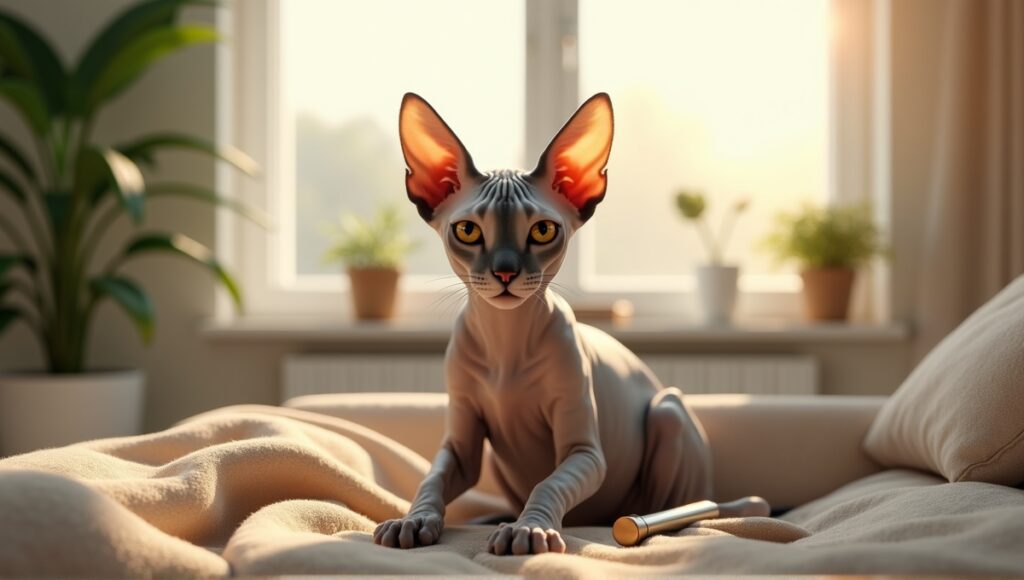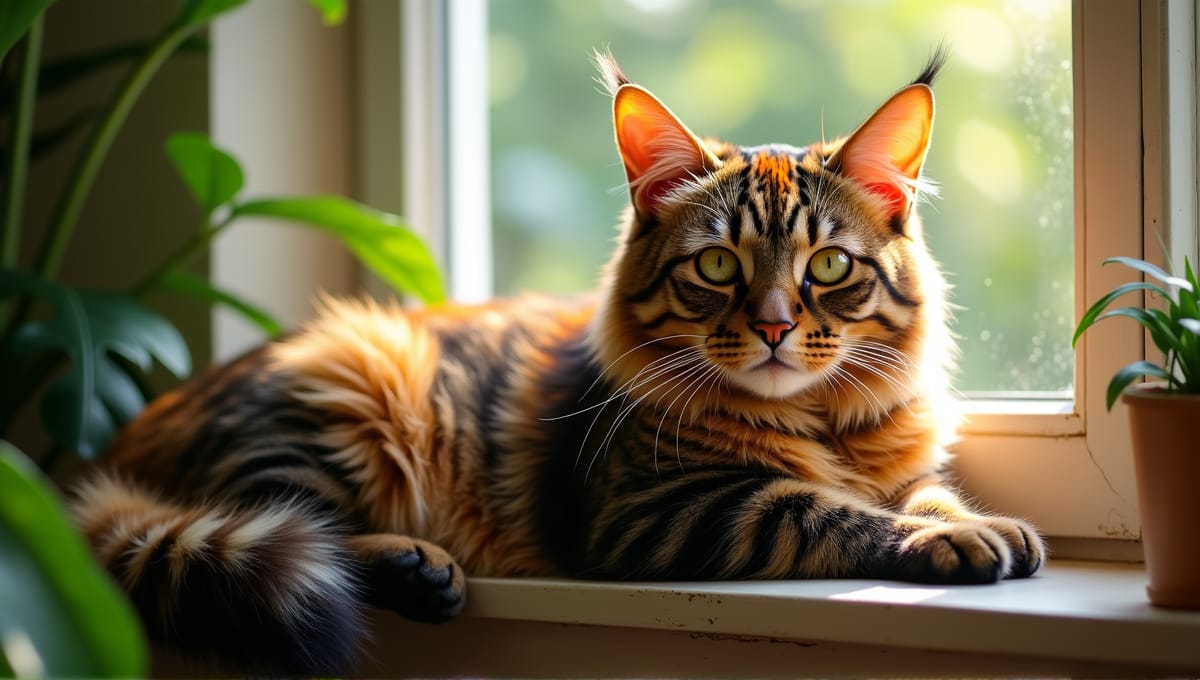I’m intrigued by hairless cats, and I often receive questions about how long hairless cats live. As an avid cat lover, I’ve done a lot of research on this topic. And you might be surprised to learn that hairless cats can live just as long as any other cat. So what does affect how long hairless cats live, and what can you do to ensure your hairless cat lives a long, healthy life?
Understanding Hairless Cat Lifespan

Hairless cats are certainly intriguing creatures. They typically live between 8 and 16 years, although some exceptional hairless cats live to be 20 years old. This is a similar lifespan to many other cat species. Yet a recent study uncovered some interesting data about the Sphynx cat, in particular.
Researchers examined data from 7,936 UK veterinary-registered cats that passed away from January 1, 2019 to March 31, 2021. To their surprise, they found the Sphynx cat had the lowest life expectancy at just 6.7 years. This conflicts with what we know about hairless cat lifespans.
Several factors will influence how long your hairless cat lives:
- Genetics
- Diet and nutrition
- Environmental factors
- Health care and vet visits
- Stress
- Exercise and mental stimulation
Genetics play a significant role in how long a hairless cat lives. There are some genetic health conditions that could reduce their life expectancy. This is why it’s so essential to select a cat from a reputable breeder who conducts genetic testing.
As a cat lover, I’ve also seen that proper care can significantly impact a cat’s lifespan. As a pet owner, you’re essentially a caretaker, as the decisions you make directly impact your hairless cat’s longevity.
If you’re looking for a specific hairless breed, consider the Donskoy cat, which has its unique characteristics and lifespan considerations.
Hairless Cat Health Concerns and Lifespan
Hairless cats, particularly Sphynx cats, have some unique health concerns that can impact how long they live if they’re not properly managed. During my time working at a specialty pet store, I learned about the most common health issues these cats experience.
The Sphynx is particularly prone to heart disease, so it’s important to take them to the vet regularly for cardiac check-ups. They also commonly suffer from respiratory issues, another byproduct of their lack of fur and susceptibility to temperature changes and infection.
Skin problems are one of the biggest health concerns for these cats. Without hair to protect their skin, they’re at risk of sunburn, acne, and other skin irritations. To prevent this, you’ll need to diligently care for their skin. Hairless cat breeds also frequently have dental health issues, so ensure you keep their teeth clean.
To prevent these issues:
- Schedule regular vet check-ups
- Establish a strict grooming schedule
- Protect your cat from temperature extremes
- Feed your cat a nutritious diet
Regular vet check-ups are the best defense against these health issues. Catching issues early can have a significant impact on treatment outcomes and overall lifespan, so don’t skip those vet appointments. They’re an investment in helping your cat live as long as possible.
As someone who has volunteered at animal shelters, I can’t stress enough the importance of preventive care. It’s much easier to prevent these problems than it is to treat them once they’ve already developed.
Nutrition and Diet for Longevity in Hairless Cats
Good nutrition is essential to help your hairless cat live a long life. Hairless cats have higher metabolic rates because they don’t have fur, which means they require more calories than their furry counterparts.
Feed your hairless cat a high-quality diet rich in protein. Look for foods where meat is the first ingredient and avoid fillers and by-products, as these won’t give your cat the nutrition it needs.
Hairless cats have unique nutritional needs:
- Higher calorie requirements
- More protein
- Essential fatty acids to keep the skin healthy
- Taurine is important for heart health
Keep your hairless cat hydrated. They lose more moisture through the skin than other cats. Keep fresh water available at all times, and some hairless cat owners will add water to the cat’s food to ensure it receives enough moisture.
You can use supplements to help your cat live longer. Omega-3 fatty acids are great for skin health and probiotics can help with digestion. However, always talk to your vet before starting any supplement routine.
I’ve personally seen many cats that are thriving thanks to a diet of well-balanced cat food. This is one of the most important steps to help your hairless cat live a long, healthy life. If you’re interested in different hairless cat breeds, consider exploring their dietary needs further.
Environmental Factors Affecting Hairless Cat Lifespan

Temperature control is a must for hairless cats. Unlike furry cats, they lack the natural insulation of fur. Therefore, you’ll have to regulate your home’s temperature throughout the year. In cooler months, you’ll also want warm cat beds and heating pads.
A stress-free environment is also essential to maximize your cat’s lifespan.
- Cats are more sensitive to stress than many people realize, and chronic stress weakens their immune system, making them more susceptible to various health issues.
- Ensure you have a peaceful, stress-free environment for your hairless cat.
Likewise, sun protection is necessary for hairless cats.
- Without fur, their skin is vulnerable to sunburn, increasing their risk of skin cancer.
- Therefore, control their sun exposure, especially during peak sun hours, and you may even have to put pet-safe sunscreen on your hairless cat.
Physical activity and mental stimulation are also important to your cat’s overall health.
- To do this, make sure you have plenty of toys, climbing structures, and other activities to keep your cat occupied.
- Additionally, plan play sessions to keep your cat in good physical shape and mentally sharp.
I’ve always said a healthy cat is a happy cat, and it’s your job to create an environment that promotes both physical and mental health.
Hairless Cat Breeds and Their Lifespans
Different hairless cat breeds will have slightly different lifespans. Let’s discuss some of the most common breeds and their typical lifespan.
Hairless breeds include the Sphynx, Peterbald, Donskoy, and Bambino. Each breed has its own characteristics and potential lifespan.
Sphynx cats typically live for 8 to 16 years. Some may even make it to 20 years with excellent care. However, recent studies suggest their average lifespan may be on the lower side of that range.
Here’s a lifespan comparison among hairless breeds:
| Breed | Average Lifespan |
|---|---|
| Sphynx | 8-16 years |
| Peterbald | 12-15 years |
| Donskoy | 12-15 years |
| Bambino | 9-13 years |
Keep in mind these are average lifespans, and individual cats will vary above or below these ranges.
Peterbald and Donskoy cats often live about the same length of time as Sphynx cats. Bambino cats, which are a cross between Sphynx and Munchkin cats, may have a slightly shorter average lifespan due to their unique body.
In my opinion, every cat is an individual. While these averages give us a rough idea, your particular cat’s lifespan will be influenced by a variety of unique factors.
Genetics and Breeding Impact on Hairless Cat Lifespan
Genetics are the single most important factor that determines a hairless cat’s lifespan. There are several genetic factors that can cause cats to develop health issues that ultimately reduce their lifespan.
Inbreeding is a major issue within the hairless cat community. Unfortunately, it has led to many hairless cats with health issues. Common problems associated with inbreeding include:
- a weaker immune system
- congenital defects
- an increased risk of disease – all of which can reduce a cat’s lifespan.
To solve this problem, breeders need to practice responsible breeding. This includes:
- genetic testing to ensure that cats don’t carry genetic diseases or disorders
- offering diversified lineages of cats to avoid inbreeding.
Genetic testing is also becoming more common in the cat breeding world to determine if a cat is a carrier of a genetic disease. As a result, more breeders are making more strategic breeding decisions to produce healthier cats that could live longer lives.
The Donskoy cat is a great example of how breeding from a genetic standpoint contributes to a cat’s lifespan. This breed has a specific genetic mutation that causes the cat to be hairless, and understanding this mutation has helped breeders maintain the cat’s health.
As someone who has researched various cat breeds for years, I can’t stress enough how important it is to purchase your hairless cat from a reputable breeder. It significantly impacts the health and lifespan of your cat.
Tips for Extending Your Hairless Cat’s Lifespan

Regular grooming is a must for hairless cats. They should be bathed regularly to rid their skin of oils that build up. Use a gentle, cat-specific shampoo. Additionally, apply pet-safe lotion to moisturize their skin and prevent it from becoming too dry and itchy.
Create a safe, stimulating environment. Identify and eliminate any potential dangers. Offer climbing trees, scratching posts, and interactive toys. This ensures your cat gets plenty of physical exercise and mental stimulation.
Quality veterinary care is also important. Schedule bi-annual check-ups. Keep an eye on your cat’s weight. Cats at a healthy, medium weight tend to live longer than those that are over or underweight.
Socialization and mental stimulation are vital for your cat’s overall well-being:
- Play with your cat and engage their mind daily.
- Use puzzle feeders to keep their mind busy.
- Rotate through new toys to prevent them from becoming bored.
- If your lifestyle accommodates it, consider adopting another cat to keep yours company.
Spaying or neutering your cat can help them live longer. Recent studies have found that unspayed or unneutered cats have a shorter life expectancy.
These tips are based on my experience with cats over the years. Remember, you’re not just caring for an animal. You’re taking care of a member of your family. Your commitment to care for your hairless cat properly will make a big difference in their quality and quantity of life.
Parting Thoughts
Hairless cats can live happy lives despite their unusual look and care requirements. They have a wide range of lifespans, but you can help them live longer by caring for them properly. Keep it healthy, ensure it’s in good health, optimize its environment, and select the right genetics. These are the steps to optimize your hairless cat’s chances of living a long, happy life. However, always remember that each cat is unique. Adjust your strategy to fit the cat to maximize the results.






